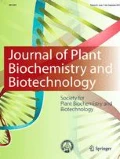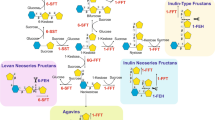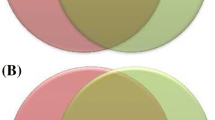Abstract
Dynamic transcriptional variations of genes encoding fructan active enzymes (FAZYs; 1-SST, 1-FFT, 1-FEHI, 1-FEHII) alongside their potential contributions regarding production/degradation of various carbohydrates (i.e., fructose, glucose, sucrose, 1-kestose, and inulin) were scrutinized in the two distinct genotypes of chicory (Cichorium intybus L.) namely “Germany variety” and “Iranian landrace”, at flowering stage. Germany variety accumulated overall more amounts of fructose, sucrose, and inulin, while Iranian landrace contained the highest proportion of 1-kestose, and glucose. Furthermore, both 1-SST and 1-FFT genes were dramatically up-regulated in the root-harvested samples of both genotypes, though maximum transcripts of 1-SST and 1-FFT were respectively detected in landrace and Germany variety, suggesting a cultivar- and tissue-dependent phenomenon. Instead, in both genotypes, maximum transcript levels of 1-FEHI were detected in stem, while root, flower and leaf tissues possessed inferior magnitudes. Considering 1-FEHII, both genotypes exhibited a down-regulated behavior in four tissues (excluding landrace stem). Meanwhile, the chicory MYB transcription factor (CiMYB17) transcriptionally fluctuated among four tissues of both chicory genotypes, and exhibited significant correlation only with 1-FEHI in Germany, a moderate correlation with 1-FEHI in landrace, and lower associations with 1-SST, 1-FFT, and 1-FEHII, indicating its trivial regulatory roles in the complex regulation of FAZY gene expression, and subsequently biosynthesis/degradation of fructans under normal circumstances. Regarding landrace, both 1-SST and 1-FFT correlated only with glucose, while for Germany variety, 1-SST had a strong association with inulin, 1-ketose, alongside glucose, and 1-FFT had a strong correlation only with glucose. However, both 1-FEHI and 1-FEHII exhibited no considerable associations with all the carbohydrates studied. Notably, 1-FEHII negatively correlated with inulin content, indicating an “antagonistic” effect between inulin accumulation/production and 1-FEHII activity. The results, overall, demonstrated that variations in genotypes and/or tissues under study can synergistically/antagonistically influence expression patterns of FAZY genes alongside production/degradation of the corresponding fructans.



Similar content being viewed by others
References
Claessens G, Van Laere A, De Proft M (1990) Purification and properties of an inulinase from chicory roots (Cichorium intybus L.). J Plant Physiol 136:35–39
Dauchot N, Raulier P, Maudoux O, Notté C, Draye X, Van Cutsem P (2015) Loss of function of 1-FEH IIb has more impact on post-harvest inulin degradation in Cichorium intybus than copy number variation of its close paralog 1-FEH IIa. Front Plant Sci 6:455
De Leenheer L, Hoebregs H (1994) Progress in the elucidation of the composition of chicory inulin. Starch-Staerke (Germany)
De Roover J, Vandenbranden K, Van Laere A, Van den Ende W (2000) Drought induces fructan synthesis and 1-SST (sucrose: sucrose fructosyltransferase) in roots and leaves of chicory seedlings (Cichorium intybus L.). Planta 210:808–814
Dong W, Niu L, Li H, Gao F (2016) Isolation and analysis of the promoter of IbMYB1. J Plant Biochem Biotechnol 25:278–284
García-Pérez MC, López MG (2016) Factors affecting fructosyltransferases and fructan exohydrolase activities in Agave tequilana Weber var. azul. J Plant Biochem Biotechnol 25(2):147–154
Goojani HG, Javaran MJ, Nasiri J, Goojani EG, Alizadeh H (2013) Expression and large-scale production of human tissue plasminogen activator (t-PA) in transgenic tobacco plants using different signal peptides. Appl Biochem Biotechnol 169:1940–1951
Hendry GA (1993) Evolutionary origins and natural functions of fructans—a climatological, biogeographic and mechanistic appraisal. New Phytol 123:3–14
Khattree R, Naik DN (2000) Multivariate data reduction and discrimination with SAS software. Sas Institute, Cary
Kusch U, Greiner S, Steininger H, Meyer AD, Corbière-Divialle H, Harms K, Rausch T (2009) Dissecting the regulation of fructan metabolism in chicory (Cichorium intybus) hairy roots. New Phytol 184:127–140
Le Roy K, Vergauwen R, Cammaer V, Yoshida M, Kawakami A, Van Laere A, Van den Ende W (2007a) Fructan 1-exohydrolase is associated with flower opening in Campanula rapunculoides. Funct Plant Biol 34:972–983
Le Roy K, Verhaest M, Rabijns A, Clerens S, Van Laere A, Van den Ende W (2007b) N-glycosylation affects substrate specificity of chicory fructan 1-exohydrolase: evidence for the presence of an inulin binding cleft. New Phytol 176:317–324
Livingston DP, Hincha DK, Heyer AG (2009) Fructan and its relationship to abiotic stress tolerance in plants. Cell Mol Life Sci 66:2007–2023
Lucchin M, Varotto S, Barcaccia G, Parrini P (2008) Chicory and endive. In: Vegetables I. Springer, pp 3–48
Maroufi A, Van Bockstaele E, De Loose M (2012) Differential expression of fructan 1-exohydrolase genes involved in inulin biodegradation in chicory (Cichorium intybus) cultivars. Aust J Crop Sci 6:1362
Michiels A, Van Laere A, Van den Ende W, Tucker M (2004) Expression analysis of a chicory fructan 1-exohydrolase gene reveals complex regulation by cold. J Exp Bot 55:1325–1333
Muir JG, Shepherd SJ, Rosella O, Rose R, Barrett JS, Gibson PR (2007) Fructan and free fructose content of common Australian vegetables and fruit. J Agric Food Chem 55:6619–6627
Nasiri J, Naghavi MR, Alizadeh H, Moghadam MRF (2016) Seasonal-based temporal changes fluctuate expression patterns of TXS, DBAT, BAPT and DBTNBT genes alongside production of associated taxanes in Taxus baccata. Plant Cell Rep 35:1103–1119
Owczarzy R, Tataurov AV, Wu Y, Manthey JA, McQuisten KA, Almabrazi HG, Pedersen KF, Lin Y, Garretson J, McEntaggart NO (2008) IDT SciTools: a suite for analysis and design of nucleic acid oligomers. Nucleic Acids Res 36:W163–W169
Pfaffl MW, Horgan GW, Dempfle L (2002) Relative expression software tool (REST©) for group-wise comparison and statistical analysis of relative expression results in real-time PCR. Nucleic Acids Res 30:e36–e36
Street RA, Sidana J, Prinsloo G (2013) Cichorium intybus: traditional uses, phytochemistry, pharmacology, and toxicology. Evid Based Complementary Altern Med 2013
Tavares CP, Terenzi H (2016) Biochemical analysis of the interaction between Arabidopsis thaliana AtMYB30 transcription factor and its DNA specific target site. J Plant Biochem Biotechnol 25:97–103
Thomas H (2013) Senescence, ageing and death of the whole plant. New Phytol 197:696–711
van Arkel J, Vergauwen R, Sévenier R, Hakkert JC, van Laere A, Bouwmeester HJ, Koops AJ, van der Meer IM (2012) Sink filling, inulin metabolizing enzymes and carbohydrate status in field grown chicory (Cichorium intybus L.). J Plant Physiol 169:1520–1529
Van den Ende W, Michiels A, Van Wonterghem D, Clerens SP, De Roover J, Van Laere AJ (2001) Defoliation induces fructan 1-exohydrolase II in witloof chicory roots. Cloning and purification of two isoforms, fructan 1-exohydrolase IIa and fructan 1-exohydrolase IIb. Mass fingerprint of the fructan 1-exohydrolase II enzymes. Plant Physiol 126:1186–1195
Versluys M, Kirtel O, Öner ET, Ende WV (2017) The fructan syndrome: evolutionary aspects and common themes among plants and microbes. Plant, Cell Environ 41:16–38
Vijn I, Smeekens S (1999) Fructan: more than a reserve carbohydrate? Plant Physiol 120:351–360
Wei H, Bausewein A, Steininger H, Su T, Zhao H, Harms K, Greiner S, Rausch T (2016) Linking expression of fructan active enzymes, cell wall invertases and sucrose transporters with fructan profiles in growing taproot of chicory (Cichorium intybus): impact of hormonal and environmental cues. Front Plant Sci 7:1806
Wei H, Bausewein A, Greiner S, Dauchot N, Harms K, Rausch T (2017a) CiMYB17, a stress-induced chicory R2R3-MYB transcription factor, activates promoters of genes involved in fructan synthesis and degradation. New Phytol 215:281–298
Wei H, Zhao H, Su T, Bausewein A, Greiner S, Harms K, Rausch T (2017b) Chicory R2R3-MYB transcription factors CiMYB5 and CiMYB3 regulate fructan 1-exohydrolase expression in response to abiotic stress and hormonal cues. J Exp Bot 68:4323–4338
Weyens G, Ritsema T, Van Dun K, Meyer D, Lommel M, Lathouwers J, Rosquin I, Denys P, Tossens A, Nijs M (2004) Production of tailor-made fructans in sugar beet by expression of onion fructosyltransferase genes. Plant Biotechnol J 2:321–327
Wilson RG, Smith JA, Yonts CD (2004) Chicory root yield and carbohydrate composition is influenced by cultivar selection, planting, and harvest date. Crop Sci 44:748–752
Acknowledgements
The current work has been financially supported by Iran National Science Foundation (INSF; 92010602) and University of Tehran, Iran.
Author information
Authors and Affiliations
Corresponding author
Ethics declarations
Conflict of interest
The authors declare that they have no conflict of interest.
Electronic supplementary material
Below is the link to the electronic supplementary material.
Rights and permissions
About this article
Cite this article
Khaldari, I., Naghavi, M.R., Peighambari, S.A. et al. Expression patterns of the genes encoding fructan active enzymes (FAZYs) alongside fructan constituent profiles in chicory (Cichorium intybus L.): effects of tissue and genotype variations. J. Plant Biochem. Biotechnol. 27, 453–462 (2018). https://doi.org/10.1007/s13562-018-0454-x
Received:
Accepted:
Published:
Issue Date:
DOI: https://doi.org/10.1007/s13562-018-0454-x




